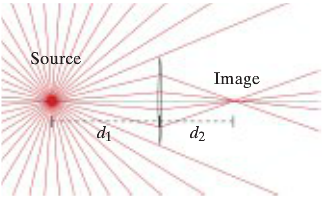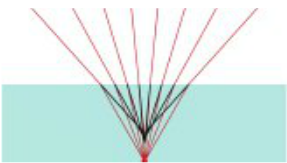Image Formation
Short Description of Topic
An image is an apparent source of light it is not a real light source because there is no actual image at the location of an image[1].
The Main Idea
Image formation by a lens depends upon the wave property called refraction.The speed of light is slower in glass than in the air, therefore a light ray will be bent upon entering and upon exiting a lens in a way that depends upon the shape and curvature of the lens.
The Thin Lens Equation
There is a geometrical relationship between the focal length of a lens (f), the distance from the lens to the bright object and the distance from the lens to the projected image. This is given by the thin lens equation.

This equation shows that all rays that start at a distance d1 to the left of the lens will cross the axis at the same distance d2 to the right of the lens. This means that if you stand farther to the right and look towards the lens you will see a "lamp" like object at the new location. By this end this is called an image because it is apparent source of light however there is no actual object at the location of the image.
Now the thin lens model or equation does have limitations. These limitations are called aberrations. Rays do come ALMOST at the same point but alas not exactly at the same point, and this difference can lead to "mistakes" or aberrations in image formation. You can see how the rays do not exactly come at the exact same point in the image below.
Virtual Image
We will now explore rays that go through weak lenses, these images the rays form are often called "virtual images".
So how do virtual images appear? Virtual images appear when outgoing rays from a point on an object always diverge, this causes the image to appear to be located at the point of divergence.Virtual images do not form visible projections on screens, however it is not "imaginary" because the image has a real position and size and also it can be seen by many different types of instruments (eyes, camera, etc). Below you can see how virtual images are formed. The rays appear to be coming from a location above the source therefore this is an example of a virtual image.
Examples
Be sure to show all steps in your solution and include diagrams whenever possible
Simple
Middling
Difficult
Connectedness
- How is this topic connected to something that you are interested in?
- How is it connected to your major?
- Is there an interesting industrial application?
History
Put this idea in historical context. Give the reader the Who, What, When, Where, and Why.
See also
Are there related topics or categories in this wiki resource for the curious reader to explore? How does this topic fit into that context?
Further reading
Books, Articles or other print media on this topic
External links
References
This section contains the the references you used while writing this page

